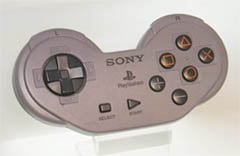Famitsu magazine, Japan’s #1 gaming publication, released an interview with a man you may not know, but who’s work you have undoubtedly used at some point in the last 15 years. His name is Teiyu Goto, and he is the designer of the original PlayStation console and the controller that single handedly transformed the nature of gaming peripherals.
It all started when he was approached to join the PlayStation project in 1993. "My boss at the time asked if I was interested in some game console work. I liked games and PCs a lot and messed around with them in my spare time, so it was great for me to work on what I liked doing the most. So I started traveling to the Aoyama office and talking with (Ken) Kutaragi about assorted things, and before long I began work on the design of the system."
Upon seeing the first playable tech demo for the PlayStation, Goto realized that he was going to be a part of something huge. "It was a huge shock to me. I couldn't tell you how neat it was to move the dinosaur around as much as I wanted. Having the hardware behind that get sold as a home game console was revolutionary to me -- if this actually happened, I thought, there's no way it wouldn't be a hit."
The system launched with an approachable, simple design, but the controller stirred up tension between Goto and his senior employees.” The console itself was a relatively easy design process, but we went through a great number of stages with the controller. The Super NES was a huge hit at the time, and naturally we wanted SNES gamers to upgrade to our system. That's why the management department didn't want the controller to be a radical departure -- they said it had to be a standard type of design, or gamers wouldn't accept it."
Goto had a different vision in his head and proceeded to create his own prototype. Upon showing it to Sony’s president, Norio Ohga, he received the administrative support necessary to butt heads with corporate. "I still clearly remember him saying that 'the control stick is the most important part of any game,'" Goto recalls of Ohga. "Ohga flies airplanes and helicopters, so he used the term 'control stick' to talk about the controller. He really liked the grips on the controller because it let him get a 3D-style grasp on the situation."
Ohga voiced his support for Goto’s grips during an internal presentation, when he called out the flat design’s lack of grips in front of management. “'This is no good! Change it! What was wrong with what you showed me earlier?' It was a huge boost for me, him saying that in front of everybody -- it made me feel like I had it right all along." "Despite that, management's opinions didn't change at all,” says Goto, “ They showed Ohga the flat controller again later and said that this is what they wanted, but Ohga was about to throw the model right back at them. I was there and I didn't want him to break the model, so I stopped him, but looking back, I think that was Ohga's way of saying 'Hang in there, Goto' to me. Management was still pretty peeved, but they felt like they had no choice but to follow him."
Goto’s reasoning for labeling buttons with symbols rather than letters also raised eyebrows among senior staff. “We wanted something simple to remember, which is why we went with icons or symbols, and I came up with the triangle-circle-X-square combination immediately afterward. I gave each symbol a meaning and a color. The triangle refers to viewpoint; I had it represent one's head or direction and made it green. Square refers to a piece of paper; I had it represent menus or documents and made it pink. The circle and X represent 'yes' or 'no' decision-making and I made them red and blue respectively. People thought those colors were mixed up, and I had to reinforce to management that that's what I wanted."
Goto’s design is a symbol of gaming that goes beyond Sony’s console. He is proud of his work and the PlayStation brand he helped create. “I was at a PlayStation party in Los Angeles once, and a man came up and asked if I was the designer of the PlayStation’, I said yes, and he said 'I develop games for a software company, but we started supporting the PlayStation because of the system's design.' I was really moved by that -- I thanked him and shook his hand as strongly as I could. That moment made me really glad to be involved with the design. Being able to launch a new brand and have people around the world use it can make a designer very, very happy."
[Source: 1UP ]

